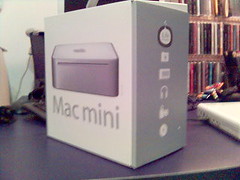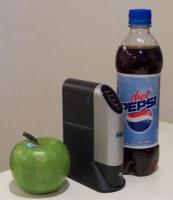The Mac user's last words: "More RAM!" ;)
 After using the Mac Mini for quite a while, I switched my primary Operating System to Linux/PPC (more exactly, Ubuntu Linux, but this might change over time).
After using the Mac Mini for quite a while, I switched my primary Operating System to Linux/PPC (more exactly, Ubuntu Linux, but this might change over time).
Meanwhile, I found out that Java is a pain on Linux, especially on the PowerPC architecture. The Sun Java packages are not available, so the only ones you can use are the GNU Java Compiler or a commercial Java variant from IBM. As the GNU version is very unfortunately quite slow (and some applications do not even run on it, for numerous reasons), I managed to install the latter. For that, I followed a Java PPC Howto in a Ubuntu forum. Quite frankly, the fact that the howto is in Chinese didn't make the process any easier, but I managed to read the important information out of the few code snippets on that site.
Now, the Java programs I want to run work quite flawlessly most of the time. Unfortunately, one of the components seems to have a memory leak. And I am not quite sure if it's the Java JRE or the (always very memory-greedy) Java-coded software I am using. Recently, it even filled up my whole system memory, including Swap, preventing me from accessing the system for almost five minutes, until the Java program crashed and I was able to work again. The system load had reached the truly magical number of 49 at this point. At least, the whole system did not crash: Respect to the stability of the PowerPC Port of the Linux OS.
In any case, even though I really like Linux on my Mac, I wanted to use OS X at some time again. But since "it is just no fun to run OS X with less than 1 Gig of RAM" (German quote), I ordered some this week. This means, I will address the challenge of opening the Mac Mini soon.
Especially as the hard drives shipped with the Mini are not pretty fast either (and therefore the Swap space is even slower than it "usually" is), I expect the upgrade to be a true relief -- because currently, the constant swapping of memory content to the hard drive and vice-versa is the most annoying thing about the little barebone sitting on my shelf.
I'll keep you posted.
P.S.: The "last words" up there I just made up myself, but they are an intentional reference to the last words attributed to the German poet Johann Wolfgang von Goethe: ("Mehr Licht" = "more light"), just in case you didn't notice ;)...

 Recently, I bought a Linksys NSLU2 network attached storage device and installed Linux on it. I have it boot over a 64 MB USB flash stick that I had to spare and I connected a ext3-formatted USB harddrive to it. It works flawlessly with Samba, serving the USB drive to all of my client OSes.
Recently, I bought a Linksys NSLU2 network attached storage device and installed Linux on it. I have it boot over a 64 MB USB flash stick that I had to spare and I connected a ext3-formatted USB harddrive to it. It works flawlessly with Samba, serving the USB drive to all of my client OSes.
